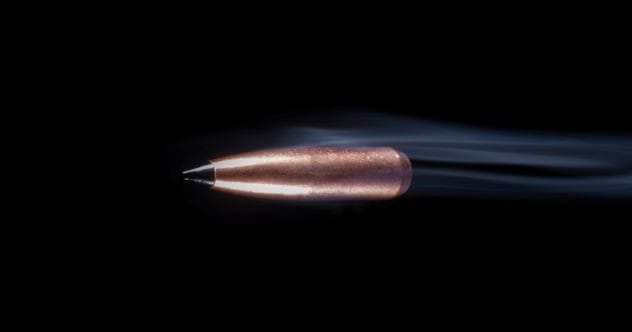Bullets might seem simple, but their journey from firearm to target involves a fascinating mix of physics. Mechanics, aerodynamics, and thermodynamics all play crucial roles in how a bullet behaves. Understanding these elements reveals the precision and complexity that make bullets fly accurately and efficiently.
This exploration dives into the science and engineering that create bullets and ammunition. We’ll uncover how bullets showcase scientific principles and technological advancements, turning these small projectiles into captivating subjects of study.
The Intrigue of Ballistic Coefficients
The ballistic coefficient (BC) is key to understanding how a bullet flies. This term measures how well a bullet overcomes air resistance during flight. The BC depends on the bullet’s mass, diameter, and drag coefficient. A higher BC means the bullet keeps its speed and direction better, with less influence from wind and gravity.
Aerodynamics explain the physics behind the BC, where the bullet’s shape and weight matter most. Long, thin bullets usually have higher BCs because they face less air resistance. This allows them to travel faster and farther with less drop and drift. That’s why sniper bullets are carefully designed to achieve high ballistic coefficients.
Optimizing a bullet’s ballistic coefficient requires balancing materials science, engineering, and physics. Manufacturers use advanced models and testing to design bullet shapes and select materials for the best BC. Innovations like boat tail bullets (with a tapered rear) reduce air turbulence, improving range and accuracy. [1]
The Paradox of Supersonic Flight and Transonic Buffeting
When bullets break the sound barrier, they deal with complex physics. Air resistance and shockwave dynamics can change their path. Supersonic travel creates a sonic boom that shows the bullet’s speed. As bullets slow down to transonic speeds (near the sound barrier), they experience transonic buffeting. This comes from changing air densities, leading to unstable airflow and potential trajectory deviations.
To fight transonic buffeting, engineers optimize bullet shapes and materials using computational fluid dynamics (CFD) and wind tunnel tests. The goal is for bullets to smoothly pass through the sound barrier while staying stable and accurate. Focus is placed on the bullet’s dimensions and mass distribution to reduce aerodynamic disturbances during this phase.
These bullet designs show how physics and engineering work together to keep bullets effective in flight. By handling the complexities of transonic buffeting, designers improve long-distance shooting precision, highlighting the impact of atmospheric physics on bullet paths. [2]
The Gyroscopic Effect: Bullets’ Hidden Stability
Bullets owe much of their stability to the gyroscopic effect, which comes from the conservation of angular momentum. This effect starts when the bullet is fired and spins due to the rifling inside the gun barrel. Like a spinning top, this rotation keeps the bullet stable and on its intended path. The right spin rate is key: too slow, and the bullet might wobble; too fast, and it might not handle air resistance well.
A stability factor, involving the bullet’s size, mass, and spin rate, helps find the best balance for stable flight. Gyroscopic drift, a slight shift in the bullet’s path due to air currents, adds another layer. It’s a predictable effect that shooters account for in long-range shooting.
The gyroscopic effect shows how physics and firearm technology combine. Rotational dynamics are essential for accurate bullets over distance, ensuring firearms remain precise tools. [3]
The Influence of Temperature on Bullet Trajectory
Temperature significantly affects bullet flight, impacting both speed and path. As temperature rises, air density drops, reducing air resistance. This allows the bullet to travel slightly faster and farther. In colder conditions, denser air can slow the bullet down, affecting range and accuracy. Warmer temperatures can also cause the gunpowder to burn faster, increasing muzzle velocity.
The effect of temperature on bullet performance is a mix of thermodynamics and fluid dynamics. Shooters must consider these variations when calculating bullet trajectory, especially in long-range shooting where even small differences matter. Advanced ballistics calculators include temperature as a key variable, helping shooters adjust their aim based on weather conditions.
Understanding and adapting to temperature’s impact on bullet flight shows how physics applies in real-world scenarios. It highlights the need for a careful approach to shooting sports, requiring shooters to know both their firearms and the physics of the atmosphere. This knowledge allows for more accurate shots in various conditions. [4]
The Impact of Humidity on Bullet Flight
Humidity, often ignored, subtly affects bullet flight. Higher humidity means more water vapor in the air, which is less dense than dry air. This can allow a bullet to travel more easily through moist air. The effect of humidity involves a balance of hydrostatic principles and aerodynamics.
Understanding humidity is vital for long-range shooters who want to calculate precise trajectories. High humidity can slightly extend a bullet’s range by reducing air resistance, while low humidity can decrease velocity and range. Ballistics calculators and weather data help shooters adjust their aim based on humidity, temperature, and wind.
Studying humidity’s effect on bullet flight shows how physics and environmental conditions shape projectile behavior. It emphasizes a complete approach to ballistics, where atmospheric science combines with mechanics to improve shooting accuracy. [5]
Bullet Spin Decay and Long-Distance Accuracy
As bullets travel, the spin from the rifle’s rifling decreases over distance. This bullet spin decay affects stability and long-distance accuracy. Initial spin is crucial for gyroscopic stability, helping the bullet stay straight. However, air friction gradually reduces the spin rate, potentially causing instability.
Spin decay involves angular momentum and torque. While the bullet’s angular momentum stays constant without external forces, air friction acts as a retarding force, reducing spin over time. This can reduce gyroscopic stability, making the bullet more susceptible to crosswinds.
Compensating for bullet spin decay is crucial for long-range shooters. By choosing bullets with the right mass and shape and optimizing barrel rifling, shooters can minimize spin decay. Advanced ballistics simulations also predict how spin decay affects trajectory, helping adjust aiming strategies. [6]
The Role of Barrel Harmonics in Bullet Trajectory
Barrel harmonics, or the vibrations in a rifle barrel when firing, significantly affect bullet accuracy. These vibrations can change the bullet’s exit point, influencing its initial trajectory. Consistent barrel harmonics are vital for precise shooting, as even small changes can affect long-distance accuracy.
Studying barrel harmonics combines mechanical engineering and physics, focusing on wave propagation and materials. Each barrel has unique natural frequencies and vibration modes. Shooters try to harmonize these vibrations so the barrel is in a consistent position when the bullet exits.
Tuning barrel harmonics might involve using barrel tuners or adapting shooting techniques. Modern software models how vibrations affect bullet flight, allowing for real-time adjustments. [7]
The Effect of Altitude on Bullet Trajectory
Altitude affects bullet trajectory due to changes in air density. Higher altitudes mean thinner air, which offers less resistance, allowing bullets to travel faster and farther. This is important for shooters, especially at different elevations. The reduction in drag can alter the bullet’s drop rate.
Shooters must adjust their sights to account for altitude-induced variations. Ballistic calculators provide adjustments for altitude and other factors like temperature and humidity.
Recognizing altitude’s impact demonstrates the application of environmental physics in shooting. It emphasizes the need for understanding atmospheric conditions. [8]
The Influence of Gravity on Bullet Drop
Gravity affects everything, including bullets. Once a bullet leaves the barrel, gravity starts pulling it downwards, causing it to arc. Understanding and compensating for gravity is essential for accuracy.
Shooters calculate bullet drop to adjust their aim, considering the bullet’s velocity, distance, and the gravitational constant. Faster bullets experience less drop over the same distance.
Modern firearms include adjustments for bullet drop. Mastering gravity’s impact shows the blend of physics and skill required in marksmanship. [9]
Coriolis Effect and Long-Range Shooting
The Coriolis effect, from the earth’s rotation, subtly influences long-range bullet trajectories. It causes bullets to deflect from a straight path, veering right in the northern hemisphere and left in the southern hemisphere. This effect increases with distance, making it vital for long-range shooters.
Accounting for the Coriolis effect involves adjusting the aim. Shooters calculate the effect based on their location’s latitude and the distance to the target. While minor for most distances, it can significantly impact extreme ranges.
Understanding the Coriolis effect shows the relationship between ballistics and Earth’s physics. It highlights the advanced knowledge needed for long-range accuracy. [10]
In summary, the physics of bullets is a complex and fascinating field. Factors like ballistic coefficients, environmental conditions, and even the Earth’s rotation play critical roles in a bullet’s trajectory. Understanding these principles is essential for achieving accuracy in shooting.
What did you find most surprising about the physics of bullets? Leave your comment below!










